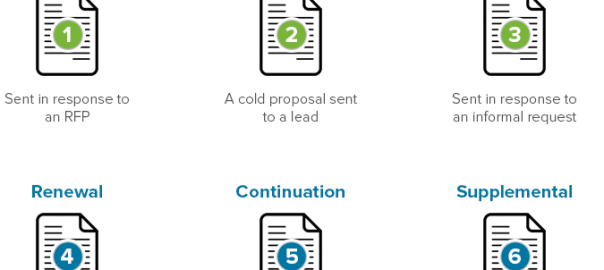— July 6, 2018
It all starts with the project proposal. From million-dollar ad campaigns to thousand-dollar one pagers, so much of your agency’s success depends on sending persuasive proposals. This guide will show you how to create more compelling project proposal outlines.
Of all the documents you’ll create while running a project, few are more important than the project proposal.
This tiny document is the seed that gives birth to million-dollar projects. You’ll use it to win new clients, persuade sponsors to increase funding, and convince existing clients to renew their contracts.
A great project proposal is at once informative and persuasive. It may revolve around data, but it doesn’t shy from using marketing copy. It is, at heart, the distillation of several skills – project management, data analysis, copywriting, etc.
Given this expansive brief, writing a convincing project proposal can be a challenge even for agency veterans.
In this guide, I’ll share 7 tips you must follow to create more convincing project proposals.
1. Understand your readers and mirror their preferences
The project proposal isn’t just a project management document. It is also a marketing document.
And as any marketing document, you have to keep your audience in mind when creating it.
In practical terms, this means using the same language, tone, style and level of complexity as your audience.
If your audience is a veteran CTO, feel free to pepper in jargon. If it’s a small business owner who has never touched a computer before, dumb things down.
Doing this means that you have to research your audience thoroughly. LinkedIn is your best friend here. Dig through their profile and approximate the following:
- Experience with your proposed solution or technology, based on past employment & education history. For example, you don’t have to explain “CRM” to a former Salesforce exec.
- Interests based on public group affiliations and recent shares. If a target is a part of a LinkedIn group on AI and has shared articles on AI/ML in the past, you can assume that he would understand AI terms.
- Busyness based on seniority and other commitments.
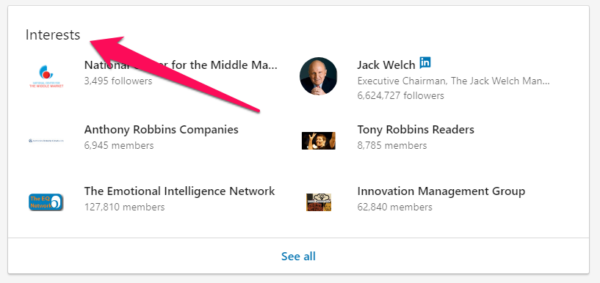
Publicly shared interests and group memberships show what your target audience is interested in.
Use this information to create a rough sketch of the target, such as this:
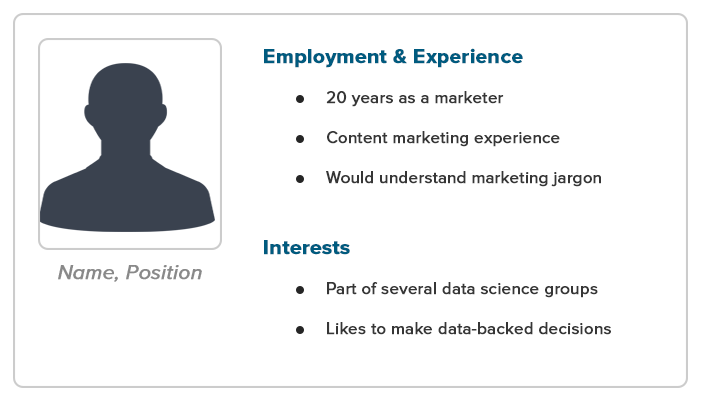
A rough profile or persona sketch can help you create a proposal that speaks directly to your target audience.
This will tell you how much detail you should include in a proposal. A veteran CTO, for instance, might want to know the technical details of your proposed solution. A small business owner might be more interested in the impact on his bottom line.
2. Address the root cause of proposal rejection
A client might reject your proposal for any number of reasons. Perhaps he isn’t sure of your ability to deliver results. Or perhaps he has a better price from a competitor.
But as Francis McNamara points out, most proposals are rejected because of a failure of persuasion, not a failure of process.
It is very seldom that sponsors discard proposals because they don’t have enough data.Rather, it is because you failed to make the data compelling enough.
Addressing this root cause of proposal requires two things:
Persuasion
Within the context of a project proposal, persuasion means two things:
- Emphasizing results that will have the biggest impact on the decision maker, i.e. its target audience.
- Countering the target audience’s rejections (with storytelling, data, and past results).
A mistake you can make is to assume that the motivations of the business and the decision maker are the same. While there is certainly a big overlap, decision-makers also have independent goals and ambitions – to get a promotion, to improve their department’s performance, etc.
Your goal should be to highlight the project results that will benefit the decision makers the most.
For example, your project might have two key benefits – improving website performance by 20% and increasing online sales by 5%.
- Pitching to the VP of engineering: Highlight performance improvements and technical underpinnings of the solution.
- Pitching to the VP of sales: Highlight the impact on sales and total revenue.
Clarity
Persuasion defines what you say in the project proposal. Clarity defines how you say it.
In practical terms, clarity is a function of the proposal’s formatting, tone, and copy. Your target shouldn’t have to read through two pages before understanding the project’s key benefit. Nor should he have to trawl through paragraph after paragraph of jargon.
To be clear, then, is to:
- Present the key benefit(s) of the project quickly and succinctly.
- Structure the proposal in a way to emphasize its biggest benefits upfront.
- Only include information necessary to make a decision and omit the rest.
- Use copy that aligns that with the target’s interests, knowledge, and busyness.
3. Justify the project’s existence by tying a dollar value to the problem
In a 2009 PMI conference paper, Eddie Merla, says that one of the chief causes of project failure is “weak justification”.
He says:
“Sometimes the concept may be properly stated but the justification for the project is weak… the lack of justification indicated a lack of commitment on the part of the team to build a compelling business case.”
This is a frequent problem on technical and creative projects. The technical or creative problem might seem substantial enough on its own. But if you can’t connect it to a business issue, you’ll struggle to justify the project’s existence.
One way to do this is to tie a dollar figure to the problem. Focus on what the business stands to lose if it doesn’t solve the problem. Since people are more likely to avoid a loss than to seek a gain (i.e. loss aversion theory), emphasizing the loss can sell the urgency and impact of the project.

For example, in a project to improve website speed, focus on how slow websites lead to abandoned carts and thus, a loss in revenue.
Try using ROI analysis to figure out the project’s impact on the business. Don’t focus on the exactness of your financial metrics. Rather, focus on their completeness.
At the very least, your proposal should highlight the following:
- The current state of the problem and its negative impact on the business
- The estimated positive impact of the project on the business
- The approximate cost of the resources required to deliver the project
A project with a “strong” justification would have a large difference between the project impact and project cost. The more “complete” you can be with this data, the easier it will be to justify the project’s existence.
4. Apply project management best practices to project proposals
A project proposal is a significantly exhaustive undertaking. You need to research stakeholders, map the relationships between them, identify risks, etc.
How can you make sure that get every detail right and still meet your deadlines?
Easy: treat the project proposal as a mini, self-contained project.
The more complex the proposal, the more you’ll want to adopt PM best practices while creating it.
For example, a complex project proposal might go through several stakeholders before it is approved. All these stakeholders will have their own concerns, goals, and preferences.
By creating a stakeholder management plan, you can address all these concerns.
Here are a few things you can do to manage the proposal creation process better:
- Assign tasks (stakeholder research, data gathering, etc.) to different team members.
- Map the relationships between stakeholders and create plans for managing them.
- Create a Gantt chart to map the proposal creation-approval process.
- Create a communication plan for each stakeholder addressed in the proposal.
- Create a risk management plan for risks identified in the proposal.
I don’t recommend doing this for every project, but if the project is large and lucrative enough, it is better to be over-prepared than under-prepared.
The best part is that you can use a lot of this data later once you actually win the project.
5. Use a conventional project proposal outline
When it comes to proposal formatting, it’s better to follow traditions than to think outside the box. Sponsors are used to seeing key information structured in a specific way. Tinkering with it will just cause confusion.
So what exactly is this “traditional” proposal format?
Use this image as a reference:
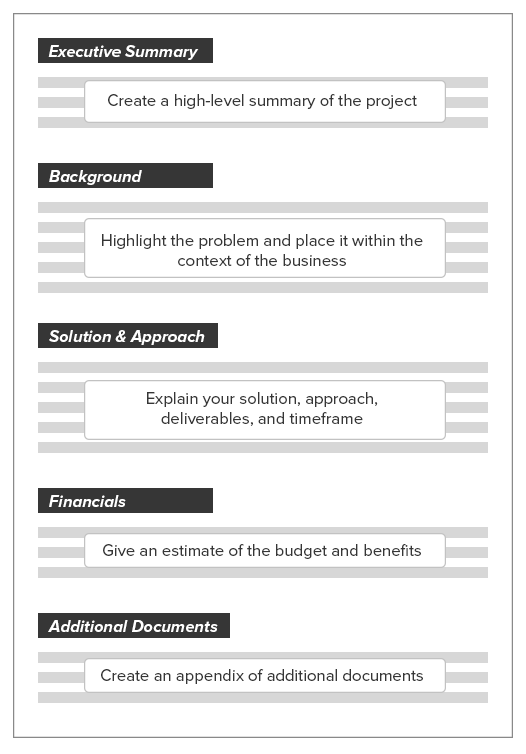
Each section in this project proposal outline serves a specific purpose:
- Executive summary gives a quick, punchy summary of the problem, your solution, and its net impact. Sponsors will often decide to read further based on this summary. Make sure that it is succinct but also sells the project.
- Project background includes a section on the history of the problem in the context of the business, a brief overview of your requirements, and a few details about your proposed solution.
- Project proposal should focus on the project’s goals and vision, key deliverables, timeframe, and ownership. Other details you can include are key risks and issues, success criteria, and reporting.
- Project financials should include details on the estimated budget and approximate financial impact post-completion.
- Project authorization should include a list of everyone who has authorization throughout the project.
- Appendix is where you can attach additional documents supporting your case.
You don’t have to use these exact headings, but I do recommend following the same core structure – summarize the problem, frame the project in context, emphasize the solution, and list the project’s financials and authorization.
6. Use persuasive copy
The purpose of a proposal is to sell the project. You can’t really expect to do that if your copy reads like it was lifted from an academic journal.
You don’t have to turn it into a sales page, but you should use at least a few persuasive writing tactics, such as:
- Use a punchy statistic, testimonial, or case study result at the start of the proposal to grab the reader’s attention.
- Avoid jargon – unless your audience is well-versed in it and expects it.
- Write at a grade 5-8 reading level. Use simpler words and shorter sentences whenever possible. Use Hemingway App to check the reading level as you write.
- Use social proof in the form of testimonials, case studies, and quotes from similar projects.
- Use the inverse pyramid writing style where you highlight the most important information at the top and push the minor details to the bottom.
- Use the 1-2-3-4 copywriting formula – identify what you’re pitching, its benefits, why you’re the right person to do it, and what the sponsor needs to do next.
- Highlight your experience, qualifications and past results. This is a form of persuasion through authority.
Don’t be afraid to use superlatives and sales-focused “power” words (“amazing”, “incredible”, etc.) in your copy. Your objective, after all, is to sell the project.
7. Reframe your content based on proposal-type
Not every proposal has the same objective. A proposal sent in response to a RFP has a different goal from one sent to renew a contract with an existing client.
In case of the former, you need to emphasize your value and experience. In the latter’s case, you’re already a known quantity to the client.
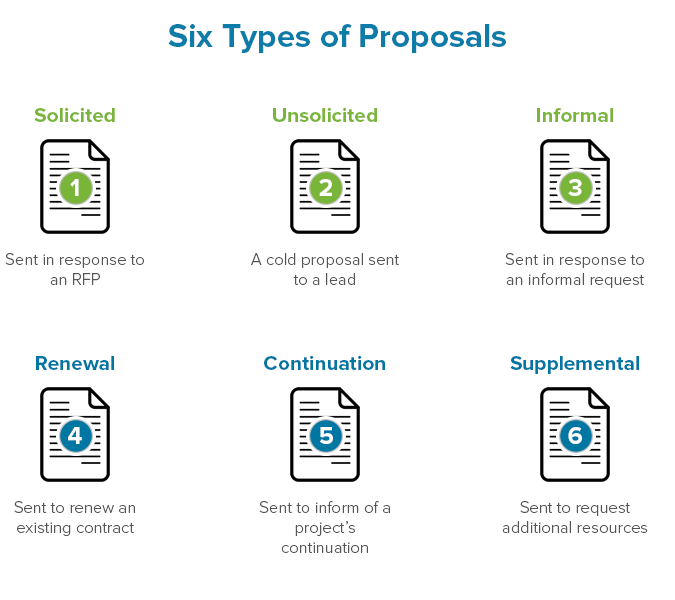
Most agencies will send the following six types of proposals:
- Solicited: These are sent in response to a Request for Proposal. You’ll be competing against several other vendors for the client’s business. Your proposal, therefore, needs to be exhaustively researched and persuasive. It also needs to adhere to the guidelines in the RFP.
- Unsolicited: These are “cold” proposals sent to prospective clients. Since the client did not ask for the proposal, you must do a lot of homework to get noticed. Bring anything but your A-game here and you’ll land straight in the trash can.
- Informal: These proposals are sent in response to an informal request from the client. While they must be sufficiently detailed, you don’t have to follow any specific guidelines (as in an RFP).
- Renewal: This proposal is sent to pitch renewal of an existing contract. Since you’ve already worked with the client, you don’t have to focus much on your work. Rather, your goal should be to emphasize your past results and how you can exceed them in the future.
- Continuation & Supplemental: These two proposal-types are largely similar. The former – continuation proposal – is sent to remind the sponsor that you’re working on a project, and to update them on its latest status. The latter – supplemental proposal – is sent to remind the sponsor about the project and request additional resources.
How much effort you put into each proposal should depend on which category it falls into. Unsolicited proposals require a lot of effort, but you can normally cut that short if you nurture leads up front.
Similarly, proposals sent in response to an RFP must be comprehensive enough to fight off competitors.
Renewal, continuation and supplemental proposals, on the other hand, should be shorter since they’ve already been approved in part.
What is the “secret sauce” in your project proposals? Share your thoughts in the comments below!
Business & Finance Articles on Business 2 Community
(151)
Report Post